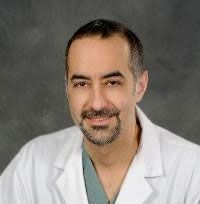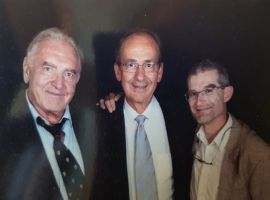
On behalf of the IPITA Education Committee, welcome to the first edition of the Beta-Cell Bulletin!
This quarterly newsletter highlights the latest and most relevant publications in our field, as well as association news, and updates on meetings and educational activities.
In this Issue:
- We have compiled a list of articles and manuscripts we hope you enjoy.
- We have launched a new great initiative, the “IPITA Curriculum on Pancreas & Islet Transplantation”
- Obituary: Jean-Michel “Max” Dubernard (1941-2021)
- Reminding our members that the IPITA 2021 Virtual Congress registration opens soon
- List of new members to Welcome in 2021

Steven Paraskevas
Editor, Beta-Cell Bulletin
IPITA Education Committee
Canada
Editor, Beta-Cell Bulletin
IPITA Education Committee
Canada
Bulletin Contributors:
Featured Article
IPITA provided advice during concept development and the formation of the writing committee for this review.
Transplant Options for Patients With Diabetes and Advanced Kidney Disease: A Review
Aleksandra Kukla, Pedro Ventura-Aguiar, Matthew Cooper, Eelco J.P. de Koning, David J. Goodman, Paul R. Johnson, Duck J. Han, Didier A. Mandelbrot, Martha Pavlakis, Frantisek Saudek, Marie-Christine Vantyghem, Titus Augustine, Michael R. Rickels,
American Journal of Kidney Diseases, 2021, ISSN 0272-6386, https://doi.org/10.1053/j.ajkd.2021.02.339.
American Journal of Kidney Diseases, 2021, ISSN 0272-6386, https://doi.org/10.1053/j.ajkd.2021.02.339.
until August 28. 2021
Pancreas Transplantation
OPTN/SRTR 2019 Annual Data Report: Pancreas
R. Kandaswamy, P. G. Stock, J. Miller, M. A. Skeans
Am J Transplant Volume21, IssueS2 Special Issue: OPTN/SRTR Annual Data Report 2019 February 2021 Pages 138-207
Am J Transplant Volume21, IssueS2 Special Issue: OPTN/SRTR Annual Data Report 2019 February 2021 Pages 138-207
Outcomes after simultaneous pancreas-kidney transplantation from donation after circulatory death donors: a UK registry analysis
Chris J. Callaghan, Maria Ibrahim, Claire Counter, John Casey, Peter J. Friend, Christopher J.E. Watson, Nikolaos Karydis
Am J Transplant 18 April 2021 https://doi.org/10.1111/ajt.16604
Am J Transplant 18 April 2021 https://doi.org/10.1111/ajt.16604
Eplet mismatch scores and de novo donor-specific antibody development in simultaneous pancreas-kidney transplantation
J.M. Ladowski, Haddon Mullins, Margaret Romine, David Kloda, Carlton Young, Vera Hauptfeld-Dolejsek, Julie Houp, Jayme Locke
Human Immunology 82 (2021) 139–146
Human Immunology 82 (2021) 139–146
First-day plasma amylase detects patients at risk of complications after simultaneous pancreas-kidney transplantation
Akseli Bonsdorff1, Ville Sallinen1, Juulia Räihä, Agneta Ekstrand, Arno Nordin, Marko Lempinen, Ilkka Helanterä
Clinical Transplantation. 2021;35:e14233.
Clinical Transplantation. 2021;35:e14233.
Recipient age and outcome after pancreas transplantation: a retrospective dual-center analysis
Franka Messner, Marjolein Leemkuil, Yifan Yu, Allan B. Massie, Felix J. Krendl, Stan Benjamens, Claudia Bösmüller, Annemarie Weissenbacher, Stefan Schneeberger, Robert A. Pol, Christian Margreiter
Transplant International 2021; 34: 657–668
Transplant International 2021; 34: 657–668
The Value of Graft Implantation Sequence in Simultaneous Pancreas-Kidney Transplantation on the Outcome and Graft Survival
Hans-Michael Hau, Nora Jahn, Sebastian Rademacher, Elisabeth Sucher, Jonas Babel, Matthias Mehdorn, Andri Lederer, Daniel Seehofer, Uwe Scheuermann and Robert Sucher
J Clin Med, 2021, 10, 1632.
J Clin Med, 2021, 10, 1632.
Recipient age and outcomes following simultaneous pancreas-kidney transplantation in the new millennium: Single-center experience and review of the literature
Komal Gurung, Jennifer Alejo, Jeffrey Rogers, Alan C. Farney, Giuseppe Orlando, Colleen Jay, Amber Reeves-Daniel, Alejandra Mena-Gutierrez, Natalia Sakhovskaya, William Doares, Scott Kaczmorski, Michael D. Gautreaux, Robert J. Stratta
Clinical Transplantation. 2021;00:e14302.
Clinical Transplantation. 2021;00:e14302.
Distal allograft pancreatectomy for graft salvage after pancreas transplantation
Daiki Soma, Tejas Nikumbh, Richard S Mangus, Andrew J. Lutz, John A. Powelson, Jonathan A Fridell
Clinical Transplantation. 2021;00:e14307
Clinical Transplantation. 2021;00:e14307
LAMS for Creation of an Anastomosis Between the Native and Donor Duodenum to Bypass a Proximal Jejunal Obstruction in a Pancreas Transplant Recipient
Jonathan A. Fridell, John A. Powelson, Andrew J. Lutz and Mohammad A. Al-Haddad
Transplantation Direct. 7(3):e665, March 2021.
Transplantation Direct. 7(3):e665, March 2021.
Impact of Simultaneous Pancreas-kidney Transplantation on Cardiovascular Risk in Patients With Diabetes
Enrique Montagud-Marrahi, Alicia Molina-Andújar, Adriana Pané, Sabina Ruiz, Antonio J. Amor, Enric Esmatjes, Joana Ferrer, Elisenda Banon-Maneus, Evelyn Hermida, Mireia Musquera, Constantino Fondevila, Fritz Diekmann and Pedro Ventura-Aguiar
Transplantation. March 02, 2021
Transplantation. March 02, 2021
Insulin secretion and action after pancreas transplantation. A retrospective single-center study
K Birkeland Bleskestad, E Nordheim, J Petter Lindahl, K Midtvedt, H Pihlstrom, R Horneland, S Lee, A Asberg, TG Jenssen, KI Birkeland
Scan J Clin Lab Invest. 2021
Scan J Clin Lab Invest. 2021
Islet Transplantation and Beta-cell Science
Phase 3 trial of human islet‐after‐kidney transplantation in type 1 diabetes
Markmann JF, Rickels MR, Eggerman TL, Bridges ND, Lafontant DE, Qidwai J, et al.
Am J Transplant. 2021;21(4):1477–92.
Am J Transplant. 2021;21(4):1477–92.
Patients with highly unstable type 1 diabetes eligible for islet transplantation can be managed with a closed‐loop insulin delivery system: A series of N‐of‐1 randomized controlled trials
Benhamou P, Lablanche S, Vambergue A, Doron M, Franc S, Charpentier G.
Diabetes Obes Metabolism. 2021;23(1):186–94.
Diabetes Obes Metabolism. 2021;23(1):186–94.
High Concentrations of Etanercept Reduce Human Islet Function and Integrity
Brandhorst D, Brandhorst H, Acreman S, Abraham A, Johnson PR
Am J Transplant. 2021;21(4):1493–502.
Am J Transplant. 2021;21(4):1493–502.
Impact of ischemia time on islet isolation success and posttransplantation outcomes: A retrospective study of 452 pancreas isolations
Wassmer C, Perrier Q, Combescure C, Pernin N, Parnaud G, Cottet‐Dumoulin D, et al.
Am J Transplant. 2021;21(4):1493–502.
Am J Transplant. 2021;21(4):1493–502.
Autoreactive T cell profiles are altered following allogeneic islet transplantation with alemtuzumab induction and re‐emerging phenotype is associated with graft function
Sabbah S, Liew A, Brooks AM, Kundu R, Reading JL, Flatt A, et al.
Am J Transplant. 2021;21(3):1027–38.
Am J Transplant. 2021;21(3):1027–38.
Chemical combinations potentiate human pluripotent stem cell-derived 3D pancreatic progenitor clusters toward functional beta-cells.
Haisong Liu, Ronghui Li, Hsin-Kai Liao, Chao Wang, Yang Yu, Lei Shi, Jiameng Dan, Alberto Hayek, Llanos Martinez, Estrella Nuñez Delicado, Juan Carlos Izpisua Belmonte
Nature Communications, 2021, 12:3330.
Nature Communications, 2021, 12:3330.
Functional, metabolic and transcriptional maturation of stem cell derived beta cells
Diego Balboa, Tom Barsby, Väinö Lithovius et al.
bioRxiv, 2021, doi: 10.1101/2021.03.31.437748
bioRxiv, 2021, doi: 10.1101/2021.03.31.437748
GP2-enriched pancreatic progenitors give rise to functional beta cells in vivo and eliminate the risk of teratoma formation
Yasaman Aghazadeh, Farida Sarangi, Frankie Poon, Blessing Nkennor, Emily C. McGaugh, Sara S. Nunes, M. Cristina Nostro
bioRxiv, 2021, doi: 10.1101/2021.03.31.437748
bioRxiv, 2021, doi: 10.1101/2021.03.31.437748
miR-212/132-Enriched extracellular vesicles promote differentiation of induced pluripotent stem cells into pancreatic beta cells
Chunyu Bai, Qiwei Ren, Haifeng Liu, Xiangchen Li, Weijun Guan and Yuhua Gao
Frontiers in Cell and Developmental Biology, 2021, 5(9), https://doi.org/10.3389/fcell.2021.673231.
Frontiers in Cell and Developmental Biology, 2021, 5(9), https://doi.org/10.3389/fcell.2021.673231.
Reviews
Pancreas transplantation would be easy if the recipients were not diabetic: A practical guide to post-operative management of diabetic complications in pancreas transplant recipients
Adam Cerise, Jeanne M. Chen, John A. Powelson, Andrew J. Lutz, Jonathan A. Fridell
Clinical Transplantation. 2021;00:e14270
Clinical Transplantation. 2021;00:e14270
Pancreas transplant versus islet transplant versus insulin pump therapy: in which patients and when?
Riccardo Tamburrini and Jon S. Odorico
Curr Opin Organ Transplant 2021, 26:176–183
Curr Opin Organ Transplant 2021, 26:176–183
Frailty in Pancreas Transplantation
Sandesh Parajuli, Fahad Aziz, Neetika Garg, Rebecca E. Wallschlaeger, Heather M. Lorden, Talal Al-Qaoud, Didier A. Mandelbrot, Jon S Odorico
Transplantation. 2021 Jan 8.
Transplantation. 2021 Jan 8.
Radiological initial treatment of vascular catastrophes in pancreas transplantation: Review of current literature
David Leiberman, Videha Sharma, Vishwanath Siddagangaiah, Edward Lake, David van Dellen, Raman Dhanda, Titus Augustine, Dare Seriki, Rajinder Singh
Transplantation Reviews 35 (2021) 100624
Transplantation Reviews 35 (2021) 100624
Working towards an ERAS Protocol for Pancreatic Transplantation: A Narrative Review
Madhivanan Elango and Vassilios Papalois
J. Clin. Med. 2021, 10, 1418.
J. Clin. Med. 2021, 10, 1418.
Protecting islet functional viability using mesenchymal stromal cells
Hubber EL, Rackham CL, Jones PM.
Stem Cell Transl Med. 2021;10(5):674–80.
Stem Cell Transl Med. 2021;10(5):674–80.
The promise of stem cell-derived islet replacement therapy
Melton D
Diabetologia. 2021;64(5):1030–6.
Diabetologia. 2021;64(5):1030–6.
The Future of Clinical Islet Transplantation in the United States
Knoll MF, Knoll CA, Bottino R, Trucco M, Bertera S.
OBM Transplant. 2021;5(1).
OBM Transplant. 2021;5(1).
Designing biomaterials for the modulation of allogeneic and autoimmune responses to cellular implants in Type 1 Diabetes
Magdalena M Samojlik, Cherie L Stabler
Acta Biomaterialia, 2021, https://doi.org/10.1016/j.actbio.2021.05.039.
Acta Biomaterialia, 2021, https://doi.org/10.1016/j.actbio.2021.05.039.
Editorials and Commentary
Islet or pancreas after kidney transplantation: Is the whole still greater than some of its parts?
Jonathan A. Fridell, Robert J Stratta
Am J Transplant. 2021;21:1363–1364
Am J Transplant. 2021;21:1363–1364
Pancreas Transplantation Alone: Radical or Rationale?
Robert J. Stratta, Jonathan A. Fridell
Transplantation: January 19, 2021
Transplantation: January 19, 2021
The demise of islet allotransplantation in the United States: A call for an urgent regulatory update
Witkowski P, Philipson LH, Kaufman DB, Ratner LE, Abouljoud MS, Bellin MD, et al.
Am J Transplant. 2021;21(4):1365–75.
Am J Transplant. 2021;21(4):1365–75.
Regulatory updates are needed to prevent the commercialization of islet transplantation in the United States
Witkowski P, Barth RN, Japour A, Javitt G, Pyda JS, Bachul PJ, et al.
Am J Transplant. 2021
Am J Transplant. 2021
Contact
Address
International Pancreas & Islet Transplant Association
c/o The Transplantation Society
740 Notre-Dame Ouest
Suite 1245
Montréal, QC, H3C 3X6
Canada






